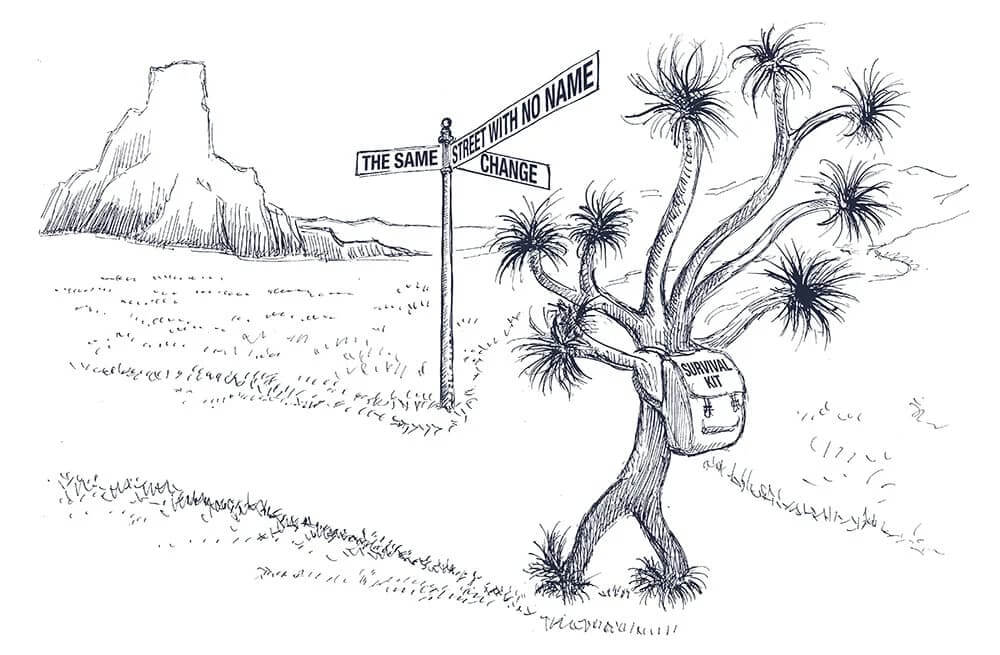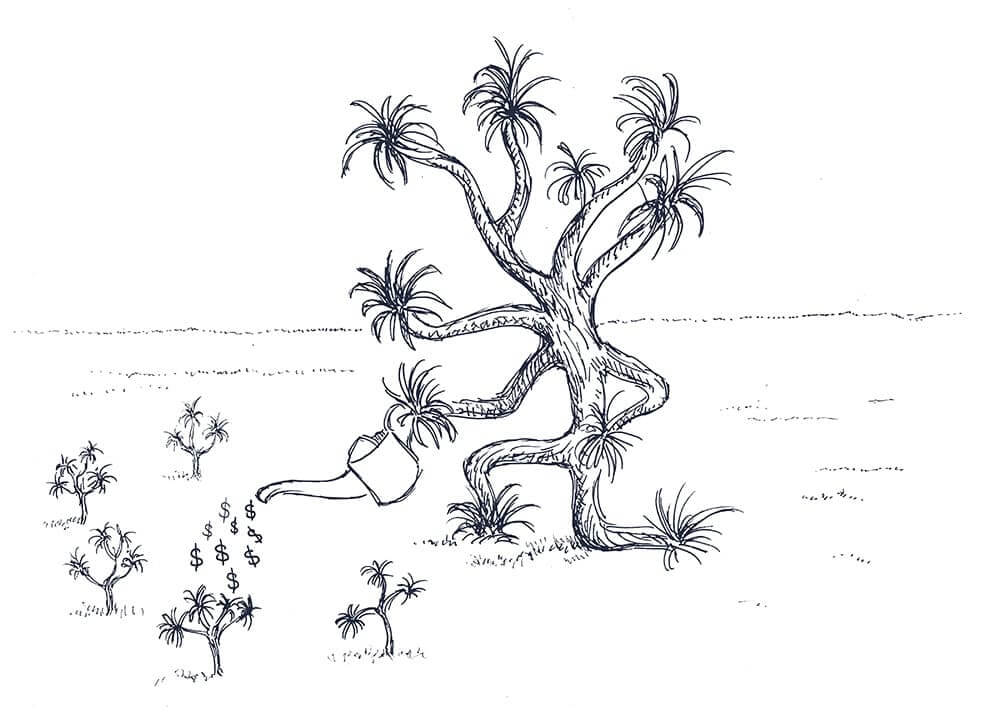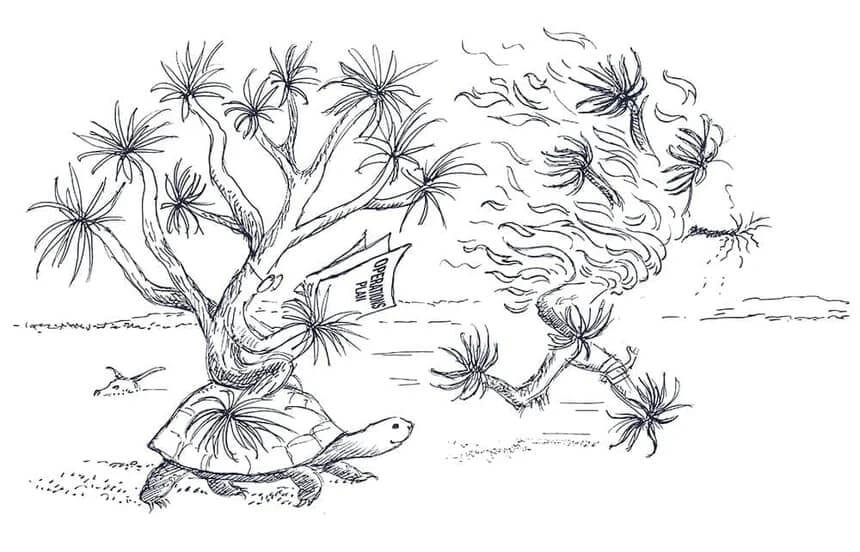When the band U2 wrote the opening title to the Joshua Tree album, “Where the Streets Have No Name,” the lyrics were in response to a story where a Belfast citizen described that their life’s limits could be identified by the name of the street they live on. The lyrics are a fitting reflection on the world we live in — both then and now.
As entrepreneurs we reject the idea that we are the sum of the predetermined parts of our origin story. We truly believe in a place where streets have no name — that we define our destiny by our own hands.
If your business, your destiny, is in your hands, 2020 has been a test.
The song and the rest of the album, discovered on my dad’s workshop boombox by accident, was the result of my storming out of the house for refuge in the yard, opening the door to the shop, and without looking slamming my hand on the play button — turning the volume to 10 in defiance.
I first fell in love with U2 as a pissed-off teenager. And no other year has felt more like those years than 2020. The year 2020 has been a caged, angsty teenager no less: too young to drive to escape, extreme mood swings, and an identity crisis. Depending on the maturity of your business, you may feel you are the caged teen or the tested and tired parent.
But with or without you, 2021 is marching ahead. While we brace for more of the same, focus on the factors you can control to position yourself for growth both on and off the balance sheet.

Survive First, Revenue Second
If 2020 taught us nothing, it was a reminder of the art of survival. If you have made it through the first grueling wave, take a moment and recognize that. Could it have been more elegant? Sure. But you made it and most likely you made some tough decisions along the way. It's easy to be a leader when times are good, but when it comes to layoffs, cuts, and pure survival? This is what you trained for, and you made it.
As we brace for more ahead (spoiler alert, January 2 will not be any different than today) pause between the battles you're fighting to notice the war you are raging.
What has changed? What has not changed?
In all cases, only one condition has changed. For example, we still crave connection — that has not changed. What has changed is how people connect with one another. Have we thrown all desire for travel and entertainment out in 2020? No. What has changed is how we can access travel and entertainment experiences in today's stay-at-home environment.
For our company what hasn’t changed is that businesses need to reach their customers. What has changed is how they reach them. In some cases, their entire communication strategy has been rewritten this year, or we have helped them solve digital transformation challenges to deliver their products and services in a new way. As a result, we have become an operations-focused marketing company, helping our customers solve communication challenges with marketing technology so they reach their customers.
In no case have we reinvented an entire business into a new existence unrecognizable from their original mission. We haven’t reinvented Illumine8 either. Instead, we have focused on fine-tuning what is working, what hasn’t changed. Helping our customers reach their customers. What has changed is how we do it.
In times like these, it is important to not get tripped in your wires of the past. Stay true to the roots of your business and what your customers value precisely. Adapt what you need to do to continue to serve that value.

Don’t Ass-ume, Communicate
If you have ever had a conversation with a teenager, you can relate to communications in 2020. Tone is implied now more than ever through email, Slack, text. Gone are the days of reading “the room.” Simple phrases are heavy with meaning. You may find yourself in a real-life meme — this is fine.
As you have adapted into a new communications pattern externally to reach your customers, focus on your internal communications with the same intensity. The new year isn’t going to bring a new wave of relief. We are all in the long journey of communicating from a distance through 2021. Those of us who master clear communication will emerge with stronger relationships both with our customers and our internal staff. If you can bring your tribe closer to your brand mission during these times, you will have more brand equity on the balance sheet in 2021 than you did in 2019.
As leaders, we are built for endurance. We recognize and know that the path we chose is not a sprint, but a marathon. The journey and challenge comprise the source of our wellspring of energy. Recognize that your team isn’t built in the same way. Fatigue is a very real symptom moving into the new year, as we all are tired from running only to stand still.
Customers and teams need more communication, not less, in these new environments. Yes, our commutes are shorter and yes our dry-cleaning bills have decreased, but the time you have saved with those errands is made up communicating to your internal customers — your team.
Not only do you need a long-term plan for survival, you need to communicate that plan to your team. There are only three things that kill a company: complacency, communication, and cash flow. Don’t let bad communication undermine the culture of your company while everyone is remote.
Don’t assume anyone can read minds or interpret subtle communications. This is not the time for nuanced communication or vague hints. Create a reliable communication network between yourself and your teams, and replicate the operations around your communications down to every employee. Encourage an open system of communication, not a closed one.
Not only is it important to foster open communication between your teams and yourself, it is also vital to work with your team to understand the weight of their words. What seems harmless to someone may be interpreted as hostile to another. Waking up on the wrong side of the bed may mean that person literally woke up on the wrong side of the keyboard that day. During COVID a text message can be a scream without raising your voice.
Take conversations out of Slack, text, and email. Not only is text communication slow and time-consuming, but it's often misinterpreted. Go new-fashioned and call through chat instead. Hurt feelings can’t be emojied away. Unchecked, these rifts can be irreparable and detrimental to your team’s overall success. As a leader, view picking up the phone the same as stopping by someone's desk. Having a bad day? Be mindful of your digital footprint. Offended? Say something. The offender? Recognize, own the apology, and move on.
Our team implemented daily huddles within teams and all-hands end-of-day summaries, in addition to keeping our weekly staff meetings and adapting them to video. While not perfect, this communication net has helped the team adapt to working remotely — and is under constant refinement as we hone our communication skills.

Follow the Money
One of two things happened in March of 2020. If you took a page from our playbook, you would have inked a recession plan (or dusted one off), reviewed expenses, ranked cuts, and set tripwires for hard decisions. Further, you communicated those plans to your team so there were no surprises. If you did this, hopefully you didn’t need to enact much of your plan in 2020.
If you didn’t have a plan in place, this may have happened to you organically. Either way, survival in times like 2020 means hard decisions around money — where it comes from and where it is going. While we can’t completely control our cash flowing into the business, one thing you do have control over is cash flowing out of your business.
Unfortunately too many view this advice solely as cuts to expenses. That isn’t the case. In times of unrest, you have the unique opportunity to review your commitments, negotiate past decisions and yes, even make investments.
Moving into 2021 we see a reversal of the trend to in-source talent. Consider, if you haven’t retained the talent, the cost of expanding it is great. The return on investment on outsourced talent for specific projects and focus areas that are not your core competencies is proven. Furthermore, if it doesn’t work out, the risk is low. It often takes almost a year to onboard a new employee to see any return in normal circumstances, nevermind remote environments where this person isn’t immersed in your culture and existing team structure. They are no more distant than a strategic partner.

Slow Down to Speed Up
When the Band-Aid of easy cash flow rips off, it’s impossible not to see the festering operational infections underneath. Cash solves problems, but it also covers them from an easy view. Once stripped away, all that is left to hold on to is your company’s processes. Without infrastructure, you can never hope to scale.
Improving your systems and processes also improves cash flow. Consider what paper cuts slash at your bottom line — mistakes, utilization, outdated business processes and models, old technology, long conversion cycles — the list is endless.
I am famous for saying “slow down to speed up” by which I mean, if we take the time to optimize at the micro level, we can create greater velocity at the macro level. Too often we skip the details in the delusion that they will not catch up with us down the line. These details show up later as costs that could have been avoided, if we had been more observant at the onset.
Optimization also needs to be accessed at the team level. A players only want to play with A players — and possibly tolerate B players. However, your A players will not put up with C players, especially not during hard times when more is asked of them. Ask yourself, who would you rehire without pause? That list is your A team. Optimization also means looking at the bench and making hard decisions. Your team would rather be a lean, underestimated basketball team of 15 than a bloated, benched football team of 55.
Teams will trim moving into 2021, and we will all be expected to be doing even more with less. Digital transformation of old labor-intensive processes will be required to set companies up to grow in the latter half of the year as we move out of the COVID era and into recovery. Those that slow down to notice the strategic advantage of optimization investments will reap the rewards of speed in the recovery.
Running To Stand Still
While 2020 leaves us searching, there is hope for the road ahead. Just like there is hope for every angsty teen, and of course hope is baked into every U2 album.
It's true, as owners and leaders we are tired. Don’t let the facade fool you — this year has tested the fortitude of everyone. Anyone that tells you it hasn’t is lying. Yet, in so many roles, we are all leaders. We need to get up and show up for our families, our co-workers, our communities. This year has been about running to stand still.
And yet, through a continuing pandemic, possible recession, and continuing reckoning with multitudes of inequality, as leaders we have navigated the unnavigable, blindly.
As we look into the future towards the coming year, it's grounding in many ways to reflect on how resilient our teams are, how adaptable our communities have been, and feel ever so slightly excited to see the maturation of the seeds of change we have sown into our organizations this year.
Instead of a passing trend for the coming year, consider a strategy. By adapting our businesses without losing our missions, being more observant to what hasn’t changed, adding brand equity to our balance sheets by continuing to improve communication, and keeping an ever-watchful eye on the actions that influence actualized cash flow, our businesses will scale into 2021.
Subscribe to the Illumine8 Newsletter

Illustrations by John Gummere

